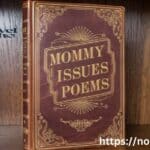The night has always been a canvas for poets to paint their deepest emotions, from the quiet contemplation under the stars to the bittersweet moments of solitude. Night poem draw from the silence, the darkness, and the moonlit skies to evoke feelings that are often hidden during the day. With short poems about the night, poets capture the beauty, mystery, and tranquility that come alive after the sun sets. These poems resonate with themes of nature, love, dreams, and loneliness, creating a delicate balance between introspection and imagination. Let’s explore some enchanting poems about the night, each with its own unique voice.
Moonlit Serenade

The Poem:
In the silence, the moon hums sweet, A serenade soft, as the stars retreat. Her light spills down in gentle grace, Kissing the earth with a silver lace.
Summary:
“Moonlit Serenade” captures the ethereal beauty of the moon as it serenades the quiet earth. The soft light from the moon bathes the landscape in a peaceful, almost musical atmosphere. The poem reflects the connection between nature and the night sky, highlighting the moon as a central figure that commands awe and admiration.
Inspiration Behind the Poem:
The inspiration behind “Moonlit Serenade” lies in the timeless relationship between the moon and stars. Poets often use the moon as a symbol of calm and mystery, and this poem seeks to personify the moon as a gentle musician, playing a lullaby for the night. The image of the moon casting “silver lace” over the earth evokes a sense of serenity and admiration for nature’s night beauty.
Night’s Embrace

The Poem:
Wrapped in shadows, soft and slow, Night’s embrace begins to grow. Velvet darkness all around, In her arms, no fears are found.
Summary:
“Night’s Embrace” speaks to the comforting, protective nature of the night. While the darkness can often symbolize fear or uncertainty, here it represents safety and solace. The velvet darkness wraps around the speaker, offering a sense of calm and peace.
Inspiration Behind the Poem:
The idea of night’s embrace as a source of comfort comes from the contrasting feelings people have toward darkness. Instead of focusing on fear, the poem highlights the night as a space for reflection and inner peace, embracing the quiet and stillness of the world as a place where no fears reside. The term “velvet” is used to show the soft, luxurious quality of the night.
Starlit Dreams

The Poem:
Underneath the stars so bright, Dreams take flight in quiet night. Whispers carried on the breeze, Filling hearts with gentle ease.
Summary:
“Starlit Dreams” captures the magic of the night sky, where dreams and imagination take center stage. The poem suggests that the tranquility of the night allows for dreams to flourish, carried by the whispers of the wind. The stars act as a guiding light, illuminating the pathways of the mind.
Inspiration Behind the Poem:
Inspired by the stars twinkling in the sky, the poem reflects on how the night fosters imagination and wonder. The nature and the night sky offer a sense of infinite possibilities, with the stars serving as a backdrop for dreams to unfold. It speaks to the idea that the night is not just a time of rest but also a time for the mind to wander and explore new possibilities.
Whispering Night

The Poem:
The night whispers secrets untold, Stories of old, in winds so cold. Through the trees, her voice does sweep, As the world drifts into sleep.
Summary:
“Whispering Night” is a poem that brings to life the sounds of the evening. The night is portrayed as a living entity, speaking through the wind and the rustling of leaves. It conveys a sense of mystery, as if the night is full of untold stories waiting to be heard.
Inspiration Behind the Poem:
The poem is inspired by the subtle, almost imperceptible sounds that fill the night air—the whispers of the wind, the rustling of trees. It taps into the mystery of the night, where even the slightest sound can carry a weight of significance. The night becomes a storyteller, whispering forgotten tales through the landscape.
Velvet Darkness

The Poem:
Velvet darkness drapes the land, A silken touch, a gentle hand. Beneath its folds, the stars align, A peaceful dance in perfect time.
Summary:
“Velvet Darkness” presents the night as a soft, comforting presence, wrapping the world in a luxurious fabric. The stars are portrayed as delicate figures, moving gracefully within the folds of the night. The poem is an ode to the night’s peaceful and soothing qualities.
Inspiration Behind the Poem:
This poem draws from the tactile imagery of velvet to describe the night. The smooth, rich fabric represents the gentle, comforting nature of darkness. By associating the night with velvet, the poem evokes a sense of warmth and security, making the night a place of solace rather than fear.
Enchanted Nocturne

The Poem:
The night is alive with a magic unseen, Where shadows dance and the moon is queen. In her light, the world’s aglow, A mystical realm where dreams may flow.
Summary:
“Enchanted Nocturne” transforms the night into a magical, almost mystical experience. The moon is depicted as the ruler of this enchanted realm, where dreams and reality blend. Shadows take on a life of their own, adding to the sense of enchantment.
Inspiration Behind the Poem:
This poem is inspired by the nocturnal symphony of the night, where every sound and shadow feels alive with magic. The moon’s reign over the night symbolizes the power and beauty that emerge when the sun disappears. The enchantment of the night is a common theme in dreams and imagination poems, where the boundaries of reality blur.
Midnight’s Whisper

The Poem:
Midnight calls with a voice so low, A secret song only few may know. In the stillness, it takes flight, Whispering soft in the quiet night.
Summary:
“Midnight’s Whisper” explores the still, almost hushed nature of the midnight hour. The poem portrays midnight as a time for secrets and quiet contemplation, a moment when the world seems to pause and listen to the whispers of the night.
Inspiration Behind the Poem:
Inspired by the quietude of midnight, this poem captures the profound silence that often accompanies the hour. Midnight is often considered a liminal time, a threshold between the old day and the new, and this poem reflects the introspective nature of that hour. The silent guardian of the night metaphor reflects the stillness and mystery midnight brings.

The Poem:
The crickets sing, the owls cry, A nocturnal symphony in the sky. Each note drifts through the moonlit air, A harmony beyond compare.
Summary:
“Nocturnal Symphony” is a celebration of the sounds of the night. From the chirping of crickets to the calls of owls, the poem highlights the way nature creates its own music under the cover of darkness.
Inspiration Behind the Poem:
This poem was inspired by the orchestra of sounds that fill the night. The night is not silent; rather, it’s filled with the natural rhythms of creatures stirring in the dark. This nocturnal imagery evokes a sense of harmony between the natural world and the night sky, making the night a time of peaceful coexistence.
Dreamscape

The Poem:
In the land where dreams take flight, We wander far beyond the night. Through stardust fields and cosmic streams, A world is born within our dreams.
Summary:
“Dreamscape” delves into the world of dreams that comes alive during sleep. The night becomes a gateway to a fantastical realm where anything is possible. It highlights the connection between the physical and the dream world, allowing for a boundless journey beyond the constraints of reality.
Inspiration Behind the Poem:
Inspired by the concept of dreams and imagination, this poem reflects the night as a time for mental escape. The stars twinkle above as silent witnesses to the dreamscape that exists within. The night, with its silence and darkness, allows the mind to explore new and wondrous realms.
Silent Guardian

The Poem:
Beneath the sky so vast and deep, A silent guardian stands in sleep. Watching over, calm and still, Protecting all with quiet will.
Summary:
“Silent Guardian” portrays the night sky as a protective figure, watching over the world with a calm and unwavering presence. The night becomes a quiet sentinel, ensuring peace and safety in its stillness.
Inspiration Behind the Poem:
This poem draws on the metaphor of the silent guardian of the night, where the night itself is personified as a figure that offers protection. The vastness of the sky, the stars, and the moon all contribute to this sense of quiet guardianship, creating a feeling of safety under the night’s watchful eye.
Lunar Lullaby

The Poem:
*The moon sings a gentle song,
Carrying weary souls along.
In her light, the dreams do fly,
Guided by her soft
Summary:
“Lunar Lullaby” likens the moon to a nurturing figure, singing a soothing lullaby to the world. The moon’s light guides those who sleep, offering peace and comfort as they drift into the world of dreams.
Inspiration Behind the Poem:
This poem is inspired by the moon and stars as comforting symbols of the night. The moon often symbolizes motherhood or protection, and this poem emphasizes that nurturing quality, casting the moon as a soothing presence. The phrase “lunar lullaby” captures the essence of the moon’s calming influence on the sleeping world.
Conclusion
Night poems capture the profound beauty, mystery, and emotions that flourish in the dark. From the quiet whispers of the wind to the twinkling of stars, the poetic themes about the night explore everything from introspection to dreams.
Each poem presents a unique vision of the night, whether it’s through the lens of nature, love, solitude, or imagination. As poets continue to draw inspiration from the night’s tranquility in poetry, they remind us that even in the velvet darkness, there is beauty, light, and peace. Whether through free verse night poems or structured forms like haiku night poems, the night remains an eternal muse, offering endless possibilities for creativity and reflection.

David Jonus is an experienced writer with a deep passion for the world of literature. As the voice behind Novel Echo, David explores the beauty of words, offering readers inspiring guides, timeless poetry, and thought-provoking reflections. With a focus on celebrating the magic of storytelling, David crafts articles that resonate with both seasoned and aspiring literature lovers.







